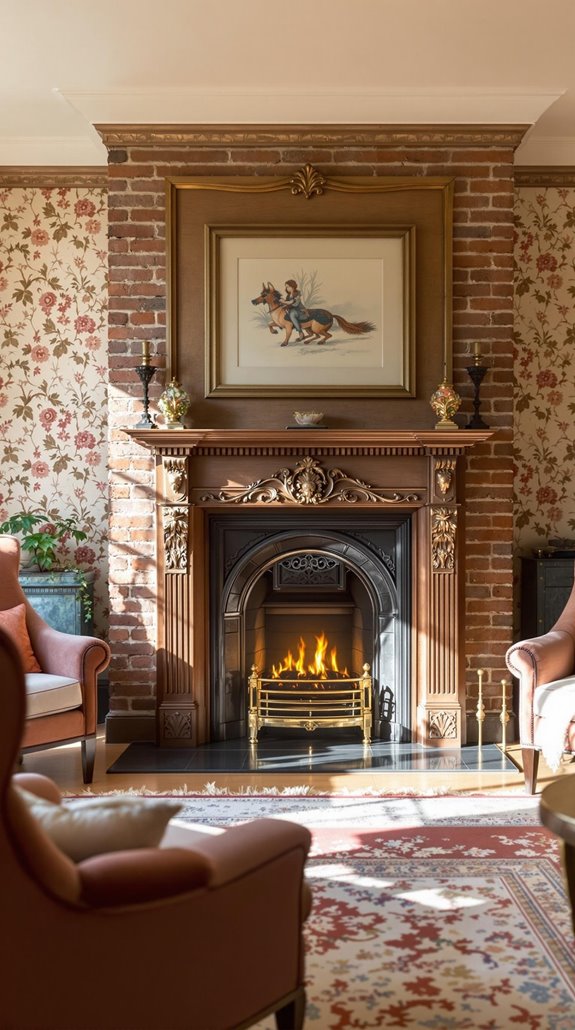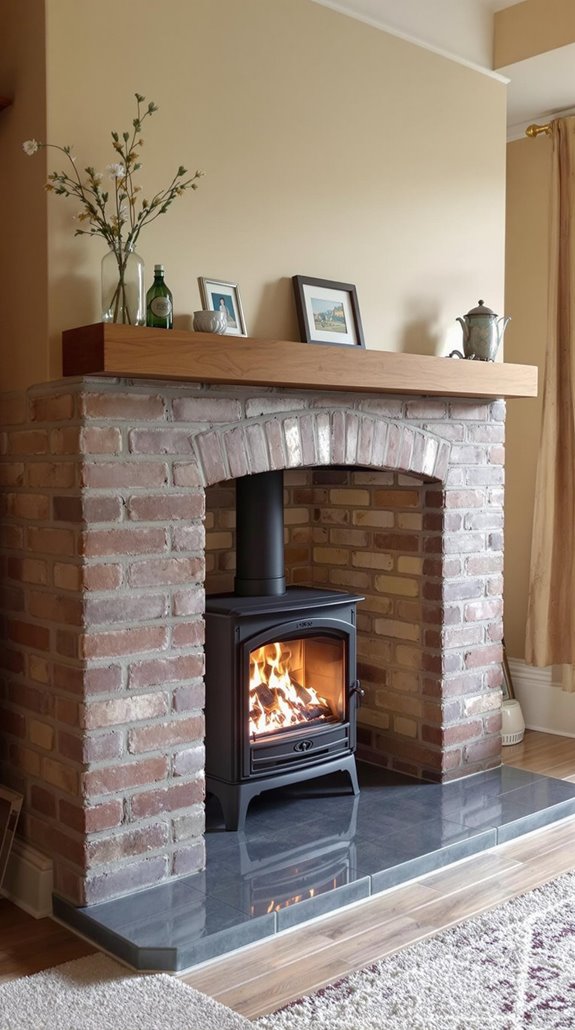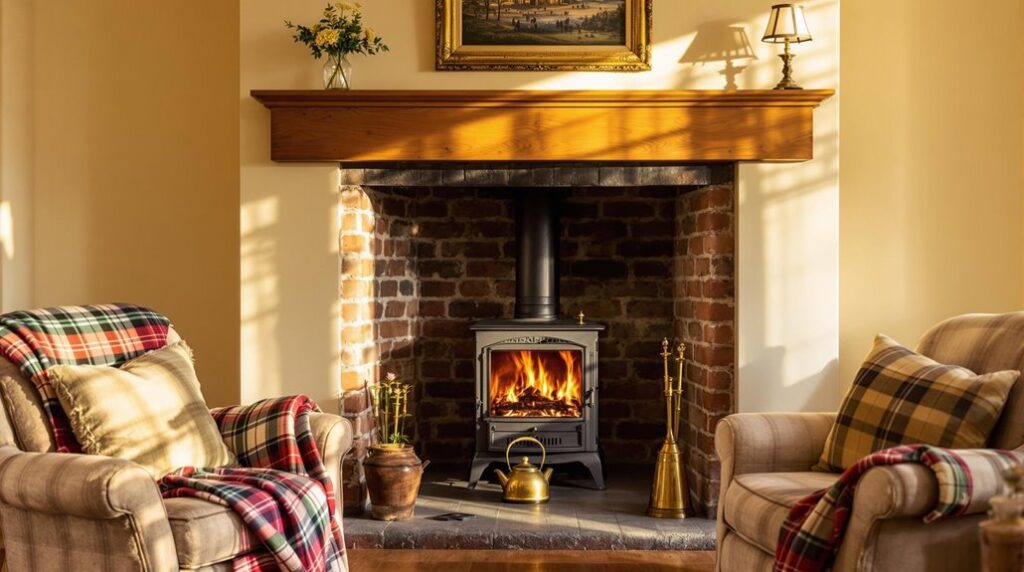I’ve helped countless UK homeowners transform their living spaces by reinstating authentic period fireplaces, and I can tell you the impact goes far beyond aesthetics. You’re not just adding a cosy focal point—you’re potentially boosting your property value by up to 5% while creating that quintessential British charm buyers crave. However, there’s a vital distinction between a rushed DIY installation and a compliant, professional reinstatement that’ll pass modern building regulations and safety standards.
Key Takeaways
- Choose period-appropriate designs like Victorian ornate mantels or Georgian marble surrounds to match your home’s architectural style and enhance authenticity.
- Hire HETAS-certified installers who self-certify compliance with Building Regulations and automatically notify local authorities, avoiding future sale complications.
- Install mandatory carbon monoxide detectors meeting BS EN 50291-1 standards at ceiling height in the same room as your fireplace.
- Use only Ready to Burn certified wood with under 20% moisture content and smokeless coal in Smoke Control Areas.
- Expect approximately 5% property value increase, with average £4,568 boost for 3-bedroom homes during colder months.
Why UK Property Values Soar With Authentic Period Fireplaces

When you’re considering home improvements that deliver substantial returns, installing an authentic period fireplace stands out as one of the most profitable investments you can make. Estate agencies consistently report that fireplaces add approximately 5% to UK property values across various property types and locations. This significant boost often offsets your installation costs entirely. Moreover, adding extra living space can further enhance the overall value of your property when combined with a fireplace.
You’ll find that authentic period fireplaces enhance your home’s aesthetic appeal, directly contributing to higher valuations. The impact becomes even more pronounced during winter months, when traditional fireplaces add an extra 1.41% value premium. For an average UK 3-bedroom home, that’s £4,568 additional value during colder months. The “hygge” atmosphere you create increases buyer interest substantially, helping you command higher prices or attract multiple offers when you’re ready to sell.
Beyond value addition, fireplaces convey a sense of opulence that historically appeals to affluent homeowners and creates an aspirational lifestyle connection for potential buyers.
Essential Building Regulations and Compliance Requirements for Fireplace Installation
While property value increases make fireplace installation financially attractive, you’ll need to navigate complex regulatory requirements before breaking ground. I’ll walk you through the essential compliance framework that governs fireplace restoration in the UK.
Your installation must comply with Building Regulations, specifically Approved Documents F, J, L, G, and P. You’re legally required to notify your Local Authority before commencing work, though HETAS Registered Installers can self-certify, streamlining the process considerably. Early detection of subsidence issues can also be crucial to ensure your property remains safe during renovations.
Structural requirements demand solid brick walls capable of supporting full weight, with adequate floor load-bearing capacity. Your builder’s opening must use non-combustible materials only. Flue work requires building control approval, visual inspection, and potentially smoke testing.
Safety measures include mandatory carbon monoxide detectors and proper ventilation. Professional HETAS installation guarantees compliance while providing certification upon completion. Building inspectors may conduct site visits throughout the installation process to ensure work meets required safety standards.
HETAS Certification: Your Guide to Professional Installation Standards

Since professional installation determines whether your fireplace meets legal standards, understanding HETAS certification becomes vital for your project’s success. I’ll guide you through why this certification matters for your home.
HETAS serves as England and Wales’ official approval body for solid fuel heating appliances, including your fireplace restoration. When you hire a HETAS-registered installer, they’ll provide a Certificate of Compliance that validates your installation meets Building Regulations requirements. This is crucial because not having proper documentation can lead to hidden costs when selling your home.
This certificate isn’t just paperwork—it’s essential for home insurance and future property sales. Buyer solicitors scrutinize these documents during conveyancing, and missing certificates can delay transactions. Your HETAS installer will automatically notify local authorities within 30 days of completing your fireplace installation.
If you’ve lost your certificate, you can retrieve it through HETAS’s website for £24 plus VAT. This documentation permanently proves your fireplace installation meets professional standards.
Choosing the Perfect Fireplace Design for Your Home’s Character
How do you select a fireplace design that harmonizes with your home’s architectural heritage while meeting modern heating needs?
I’ll guide you through matching fireplace styles to your home’s character. Victorian homes demand ornate mantelpieces with carved floral motifs and decorative tiles in bright colours. Georgian properties suit generous proportions with classic acanthus leaves or Greek key patterns—choose marble for authenticity or painted wood with faux veining for budget-conscious renovations. Regency homes benefit from refined marble construction with signature S-curved corbels and bullseye roundels.
For period cottages, I recommend premium limestone or sandstone surrounds paired with aged oak mantels. These hand-carved elements become architectural investments that appreciate over time. Additionally, consider that fireplace renovations can enhance the overall charm and efficiency of your living space. Consider your home’s proportions—compact spaces need shorter designs, while grand rooms accommodate larger statements. Professional designers prioritize these permanent focal points over temporary décor. Victorian fireplaces historically functioned as social hubs where families gathered, making them ideal for creating warm, welcoming spaces in contemporary homes.
Modern Eco-Friendly Stoves That Meet 2025 Efficiency Standards

When choosing a replacement stove for your fireplace, you’ll need models that comply with the UK’s Ecodesign regulations—mandatory standards that have transformed the market since January 2022. I recommend looking for stoves achieving ≥75% thermal efficiency, which reduces your annual fuel consumption by 30% compared to older models. You’ll benefit from advanced combustion technology that cuts particulate emissions by up to 90%, addressing our shared responsibility for cleaner air. Additionally, consider the affordable log burner installation options that can help you manage costs effectively.
Ensure your chosen stove includes features like baffle plates, enhanced airflow systems, and real-time airwash technology. These components maximize heat output while maintaining glass clarity. Remember, you’ll need DEFRA-approved certification for legal compliance, especially in smoke control areas. Premium models with integrated moisture sensors automatically adjust burning conditions, ensuring you’re always meeting the strict emission thresholds we all must follow. Consider HETAS approved installers who ensure compliance with building regulations and provide proper documentation for insurance protection.
Fuel Compliance: Ready to Burn Wood and Approved Smokeless Coal
Compliance with UK fuel regulations determines whether you can legally operate your reinstated fireplace without facing penalties or enforcement action. I’ll guide you through what’s permitted and what’s banned.
You can’t use wet wood in quantities under 2m³ or bagged house coal—both banned since May 2021. Traditional house coal’s completely phased out by 2023. Instead, you must use Ready to Burn certified wood with moisture content below 20%, or smokeless coal approved for Smoke Control Areas. Maintaining compliance with the Decent Homes Standard is crucial for ensuring your property meets safety and comfort requirements.
Look for the Ready to Burn logo when purchasing fuel. Check your local authority’s website to confirm if you’re in a Smoke Control Area, where only Defra-approved fuels are permitted. Non-compliance results in fixed penalties starting at £175, with repeat offenders facing £300 fines.
Regular maintenance of your reinstated fireplace and chimney is essential to ensure optimal performance and prevent excessive smoke emissions that could trigger enforcement action.
Safety First: Carbon Monoxide Detection and Clearance Requirements
Before you strike your first match in that reinstated fireplace, you’ll need proper carbon monoxide detection installed and functioning. Installing a new fireplace triggers mandatory CO alarm requirements under current UK regulations, regardless of whether you’re owner-occupied or renting.
You’ll need a sealed-battery or hardwired alarm meeting British Standard BS EN 50291-1. Mount it at ceiling height in the same room as your fireplace—CO is lighter than air and rises. Plug-in units won’t cut it; only sealed-battery or mains-powered alarms are permitted. Additionally, ensure you are aware of potential landlord fines related to non-compliance with safety regulations.
Position the detector 1-3 meters high, following manufacturer guidelines. Test monthly and replace according to the unit’s lifespan, typically 7-10 years. This isn’t just good practice—it’s essential protection for your family’s safety.
Non-compliance with CO alarm requirements can result in penalties of up to £5000, making proper installation both a safety necessity and a legal obligation.
Ongoing Maintenance Schedule for Peak Performance and Safety
After you’ve installed your carbon monoxide detector and struck that first match, you’ll need to establish a rigorous maintenance schedule to keep your fireplace operating safely and efficiently. I recommend removing ash after every 2-3 fires using a metal lidded container, and cleaning ash traps weekly during active burning periods. You’ll want to scrub your firebox every few weeks and clear creosote from glass doors monthly with specialized cleaners.
Surveyors often look for signs of damp issues during property surveys, which can be crucial if your fireplace is in a damp area. Schedule professional sweeping annually for wood-burning systems, twice yearly for coal, and quarterly for biomass pellets. I suggest examining firebox brickwork quarterly for cracks and testing damper seals monthly. Check chimney caps biannually for damage, and always use seasoned hardwoods with less than 20% moisture content for peak performance. This maintenance routine prevents costly repairs that could arise from neglecting your chimney system over time.
Victorian and Edwardian Styles That Captivate Modern Buyers

The timeless appeal of Victorian and Edwardian fireplaces continues to drive property values and buyer interest across the UK’s housing market. I’ve noticed Victorian designs attract buyers seeking bold focal points through their intricate carvings, dark marble mantels, and robust cast iron surrounds that showcase historical authenticity. You’ll find these pieces feature Gothic-Renaissance influences with ornate floral motifs that command attention. Furthermore, understanding the importance of listed status can help homeowners make informed decisions when restoring these beautiful features.
Edwardian styles offer different advantages for modern homes. Their lighter proportions, neoclassical elements, and brighter colour palettes integrate seamlessly into contemporary spaces. I recommend Edwardian fireplaces for smaller rooms where their refined silhouettes won’t overwhelm the space. Both styles retain excellent investment value, but Victorian cast iron’s exceptional durability makes restoration projects particularly worthwhile for discerning homeowners. During the Victorian era, fireplaces transformed into genuine status symbols as increased wealth from the Industrial Revolution allowed middle and upper classes to demonstrate their prosperity through these elaborate home features.
Conclusion
I’ve covered everything you need to successfully reinstate your fireplace while maximizing your home’s value and safety. You’ll need proper HETAS certification, compliance with building regulations, and the right design for your property’s era. Don’t forget carbon monoxide detection and regular maintenance schedules. Choose eco-friendly stoves meeting 2025 standards with approved fuels. Follow these technical requirements, and you’ll create that coveted cosy charm while boosting your property value by up to 5%.
References
- https://fireproof.co.uk/fire-safety-in-2025-key-policy-changes-and-what-they-mean-for-you/
- https://ncc-flue.co.uk/blog/new-wood-burning-stove-regulations-for-2025/
- https://www.gov.uk/government/publications/furniture-and-furnishings-fire-safety-regulations/furniture-and-furnishings-fire-safety-amendment-regulations-2025-uk
- https://www.britsafe.in/safety-management-news/2025/2025-uk-fire-safety-regulation-updates-a-quick-guide
- https://www.britsafe.org/safety-management/2025/2025-uk-fire-safety-regulation-updates-a-quick-guide
- https://www.antiquefireplace.uk.com/can-a-fireplace-add-value-to-your-home
- https://www.sold.co.uk/home-improvements/fireplaces-house-value/
- https://www.zoopla.co.uk/discover/property-news/6-hot-property-features-that-add-value-in-summer/
- https://www.6wresearch.com/industry-report/united-kingdom-uk-fireplaces-and-stoves-market-2020-2026
- https://www.superiorfireplaces.co.uk/average-uk-house-prices/

